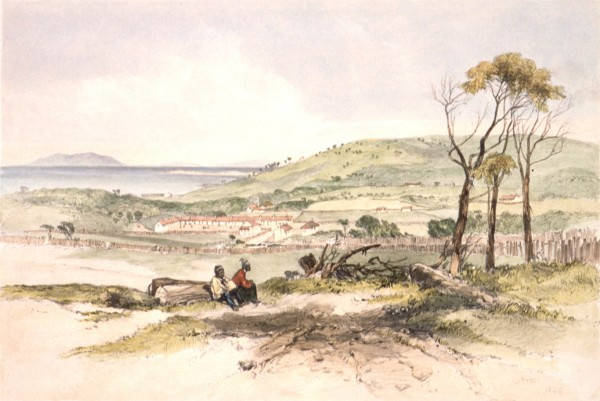 |
 |
|
Wybalenna
Many hundreds of visitors go to Wybalenna (Black Man's House) on Flinders Island every year, with the intention of visiting the historical chapel there, but they may be completely oblivious to the fact that the church sits on a site where hundreds of Tasmanian Aborigines died, while waiting to return to their traditional country on the mainland of Tasmania as promised by George Augustus Robinson as part of his Friendly Mission. Wybalenna was established as the so-called 'Aboriginal Settlement' in 1834 and when it opened housed 134 Aborigines, placed there for the purpose of being 'Civilised and Christianised'. Some well-known inhabitants of the 'Settlement' were Mannalargena of the Trawlwoolway people (died at the site), and Truganini of the Nuenonne people (wrongly recorded as the last Tasmanian Aborigine). However, only 47 Aborigines remained, and in 1847 they were transferred to Oyster Cove south of Hobart. Wybalenna for the main part was subsumed into the mainstream way of life on Flinders Island, and would most likely have been seen as 'unremarkable'. If it were not for the cemetery, the chapel, the occasional sheep grazing lazily on the windswept pastures with tourist and local alike looking for a good camping spot, Wybalenna would have been forgotten by the majority of people. This started to change in the late 1970s and early 1980s, because with the rise of Aboriginal activism in Tasmania, many Aborigines saw the importance of Wybalenna and sought to have it protected from those who would run their cattle over the unmarked graves left behind after the closing of the settlement, and stop the ongoing desecration of the remaining ones. There were several attempts to fence in the 'Aboriginal Section' of the cemetery, but the fences were removed. Through persistence driven by the need of Tasmanian Aborigines to protect the area, a fence was finally erected to protect the graves from further destruction. All seemed well until 1991, when a group of Aborigines living at Lady Barron on Flinders Island made the decision that if Wybalenna was not returned under proposed Tasmanian legislation, they would have no alternative than to reclaim the area and take over management of it. With this action came a public awareness, or perhaps revival of social conscience about not only the area but the whole sense of Aboriginality on the Island, and this is clearly visible in the documentary made by Steve Thomas called 'Black Man's Houses'. In late 1991 a small group of approximately ten Aborigines re-occupied the site and made it clear that they had reclaimed the area in the name of the Aborigines living on Flinders Island. This was never more evident than with the sign that hung on the gate which said 'You are now entering Aboriginaland, please respect our culture'. The Tasmanian Government in its Aboriginal Lands Act (1995) returned the land to the Tasmanian Aborigines through the vesting of title in the Aboriginal Land Council of Tasmania, with management vested in the Flinders Island Aboriginal Association Incorporated. In 2004, there was still no comprehensive agreement between the Aboriginal Land Council of Tasmania and the Flinders Island association, so the involvement of the Aborigines on Flinders Island is still minimal and although the site is back in Aboriginal hands, it still holds a sense of sorrow surrounding the attempted assimilation and genocide of Tasmanian Aborigines. Further reading: N Plomley (ed), Friendly mission, Hobart, 1966; J Clark, The Aboriginal people of Tasmania, Hobart, 1983; H Reynolds, Fate of a free people, Melbourne, 1995; J Walker, Early Tasmania, Hobart, 1989; M Shaw, 'Wybalenna and the treaty of Whitemark', Indigenous Law Bulletin, July 1999. Glenn Shaw |
Copyright 2006, Centre for Tasmanian Historical Studies |
